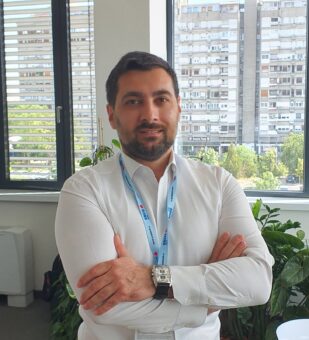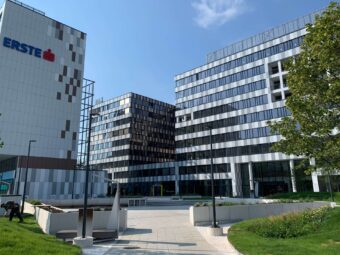
Reducing support for the fossil fuel industry and, on the other hand, understanding and supporting those sectors of the economy that have a significant impact on reducing pollution and climate change enable the financial sector to make a decisive impact in the energy transition. Erste Bank Serbia has so far financed more than 60 projects in the renewable energy industry (RES). Thanks to their credit support, 400 megawatts of capacity have been built that produce clean green energy from wind, water, solar, biomass and biogas. We talked about the market situation, projects and plans with Aleksandar Savić, Head of public sector and specialized lending department of ERSTE Bank.
EP: Tell us more about RES financing projects in Serbia. What did the new law bring? How do you approach the selection of projects, and which projects do you finance?
Aleksandar Savic: When the first regulation on incentives for RES projects was adopted in December 2009, Erste Bank was practically a pioneer in their financing. The first project was financed in April 2010, and in accordance with its name (Erste, German, first – editor’s note), we financed the first biogas plant and the first wind farm in Serbia.
All these projects are financed on the basis of feed-in tariffs adopted by regulations, and the legislative framework is defined within the Law on Energy. In April 2021, the first law dealing exclusively with the use of RES was passed (the Law on Rational Use of Energy and the Law on Energy Efficiency were passed in parallel), and solutions were implemented in most Western European countries. The most significant change is certainly the transition from feed-in tariffs to the auction mechanism. For banks, the auction mechanism with a bilateral premium represents a similar level of price risk mitigation. Still, the achieved price at the auction is crucial for the successful implementation of projects.
So far, no auction has been held, but the first auction for wind farms was announced in November last year. The proposed starting price was 55.7 euros per MWh, and having in mind not only the current circumstances on the electricity market but also the expected trends, as well as the situation on the equipment market and the current level of investment, the offered maximum price was not adequate.
Another big novelty is the introduction of the producer-consumer institution, the so-called prosumer, into the legal framework. This has greatly opened up the tremendous potential for building new solar photovoltaic capacities. When it comes to project selection, the process is quite complex. So far, we have financed over 60 projects of all types of RES available in Serbia, except geothermal ones.
In focus:
EP: How important is the support of KFW, the World Bank or the EBRD through funds, and how important is the support of our country?
Aleksandar Savić: The support of international financial institutions is of great importance. Most of these projects were implemented using the credit lines of these institutions, and in a large number of cases, these lines also carried a significant part of the grant component (grants). As for the support of our state, it is the most important in the legal security of investment and simplified and expeditious administration.
When it comes to subsidies, it is necessary to take a more serious approach and look in the right way at what constitutes their most rational use. Otherwise, we may find ourselves in absurd situations such as the fact that as a state, we subsidize the purchase of electric vehicles in the amount of 5,000 euros in a situation where they pollute significantly more than EURO 6 petrol and diesel vehicles due to the current energy mix.

EP: What is the significance of the green energy sector and other forms of sustainable development for the banking se- ctor in Serbia? What is new in this field in the bank’s business policy? Does Erste Bank plan to provide additional capital to finance sustainable development in Serbia?
Aleksandar Savić: For most of the leading banks in Serbia, this sector is already very important and given the current circumstances and future expectations, I am sure that it will (if not already) become the most important because the issue of energy transition and sustainable development becomes the most important social issue. This trend must also be reflected in the way banks view the environment in which they operate, which inevitably results in changes or the introduction of new business practices and policies.
Clients will increasingly receive questions from banks that were not there before and may seem “non-banking” at first glance. For example, a natural person seeking a housing loan may be asked which energy class the property he is buying belongs to. The legal entity may receive questions regarding the amount of waste produced annually, fuel consumption, water and the like. I am sure that such issues in the future will determine not only the price of borrowing, but in certain cases, the possibility of the same. That speaks a lot about the significance.
EP: What are the world trends regarding RES financing, and is Serbia on the right track? Can you single out some examples of good practice from Europe that we could copy in our country as well?
Aleksandar Savić: It may be hard to believe, but Serbia used to be a leading country in using RES. The first hydropower plant in Europe was built in Serbia (only 19 years after the first hydroelectric power plant in the world, near Niagara). It is the SHPP “Pod Gradom” near Užice, which was put into operation in 1900, and is still in operation. We should not forget the hydro-capacities that were built during the last century. Unfortunately, due to various circumstances and factors, we are currently one of the least developed countries in terms of using RES in Europe. We still mostly (70 percent) produce electricity by burning low-calorie lignite. We do not use the potentials we have in the field of RES. For example, in the Czech Republic, which according to almost all data, is comparable to Serbia (agricultural production, arable land, generated organic waste), over 330 MW of biogas plants are currently installed (by 2030, the plan is to reach 485 MW). In Serbia, it is about 30 MW – 11 times less.
I believe the market has already resolved the issue of return on investment. In this area, state support is not crucial (although the actual production price of electricity produced from coal and the price at which scarce electricity is procured are far higher than those at which adequate capacity from RES can be obtained). Still, efficient, cheap, and fast administration is certainly the part where the biggest progress can be made.
Interviewed by: Milica Marković
Read the story in the new issue of the Energy portal Magazine RENEWABLE ENERGY SOURCES.



